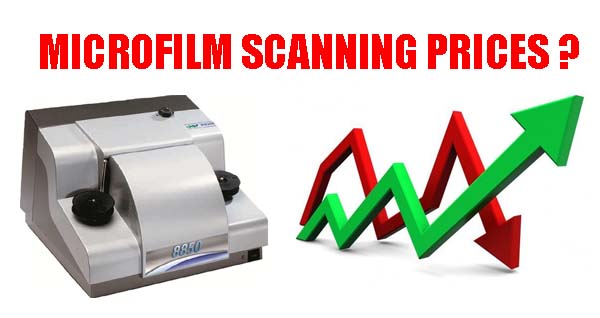Microfilm scanning prices represent the total cost to digitize microfilm in a digital format. We always include the logistics involved, the cost of actual scanning and other value-added services. Therefore we will convert your microfilm digitally while keeping a close eye on costs and other financial aspects.
Working together on your requests and needs, we will be able to provide the best rate for your project. We think this will improve the overall quality of your microfilm scanning project and also reduce costs in the process.
Our Microfilm Scanning Prices
We can scan both 16mm and 35mm microfilm. Our microfilm digitizing cost is different depending on the media you need scanning.
- Convert microfilm to digital cost for 16mm microfilm – The prices for this size of microfilm start from 0.02 £ / page. This is for rolls that contain at least 2000 images. We will give you discounts for quantities of at least 10 rolls so please enquire.
- Digitizing microfilm cost for 35mm microfilm – The cost for 35mm microfilm scanning starts from 0.08 £ /page. Most 35mm rolls contain around 500 images. If you have more than 10 rolls please enquire to get a better quote.
- Microfiche scanning prices – This will vary, but for simple microfiche it can be as low as 2 £ / Fiche
The value of your microfilm scanning project
Before beginning such a process you should always evaluate what will be the value of your project. What the project brings, whether it is a financial value or increasing productivity. The value of the output of your project is very important in this
Based on what you expect from scanning, the microfilm scanner prices you get in your offer should match this. In this sense, the more work the provider puts in the higher the price will be. If your documents only require standard capture, then your price will be smaller than for other projects.
Finding fix prices for microfilm scanning is difficult. We always recommend you talk with providers before going through the actual process. Most providers will work with you through the quoting phase. They will evaluate what you have, and offer the best rate possible.
For example, we always recommend users to test our service before making the order. This way we can evaluate the work directly and we make sure we don’t overcharge them for the work.
What influences our microfilm scanning prices.
There are quite a bit of factors that influence the microfilm scanning prices. For example the size of the microfilm, 16mm or 35mm. Then we have the bitonal or grayscale capture of information. Supplying post image processing or not. Last but not least, providing indexation of information is again critical.
Scanning 16mm or 35mm microfilms and how that influences prices
First of all you need to take into account the microfilm scanner cost. The price of the scanner will be different based on its capabilities, such as scanning 16mm or 35mm microfilm.
Pricing for the 2 items is not the same. The reason is quite simple. A 16mm roll usually has a lot more documents on it than the 35mm microfilm roll. Usually, the 35mm rolls have around 3 times fewer documents on it. Fewer documents mean fewer changes to settings. It also means fewer crops and 3 times less quality control. In the end, this adds up to the amount of work. It also adds up to costs.
In most cases, we think that we will be able to supply a better price to a 35mm than a 16mm roll. Not to mention that on a 35mm microfilm roll, the reduction ratio is not that big. Therefore the details are bigger and clearer. This eases the capture process quite significantly.
Grayscale or bitonal capture
As we also mention in other articles, we can capture microfilm in both bitonal and grayscale. But what are the differences and where one helps or it just increases the price for no helpful reason?
Bitonal scanning – This type of scanning is suited to capturing text-based documents or forms. Most pages on microfilms are like these. But to be able to capture them successfully you have to make sure this is enough. By this, we mean that the page must be binary, so it will replace each pixel with black or white. If this is enough to make the page readable, bitonal scanning is enough.
There are some text pages that require grayscale scanning. These are usually old pages or forms, that have both handwriting and typewriting or the handwriting is very thin and is barely noticeable. For such documents, grayscale scanning is a must. You can see this will also increase the prices for microfilm scanning.
Grayscale scanning – As mentioned above, grayscale provides 256 levels of color in your document. This means that the image contains shades of gray, which can replace certain tonal values. It also allows you to successfully post-process the images. Using the bitonal scanning, your image will be binary. This makes post-processing almost impossible.
You can clearly see that each one involves a certain amount of effort and costs. These affect the microfilm scanning prices quite significantly. Grayscale scanning involves more work and if you combine it with image processing it will increase costs significantly
While bitonal scanning seems identical, it involves less effort and also fewer costs. The end user can expect a smaller price for this service. Even writing a grayscale film is more costly. While the microfilm cost is identical, as it’s the same film, the processing chemicals and the procedures involve more effort therefore a higher price.
Image post-processing when scanning microfilm
Post processing the images that you scan is required in certain cases. For example when you scan documents with pictures, or documents which involve shades of gray. Such cases are on microfilm that contains land documents, genealogy documents or even copyright holders. These kinds of microfilms require post-processing and image correction.
While digitizing microfilm is pretty straightforward, the original image changes when you microfilm it, then with time and so on. There are just too many factors involved with microfilming, to maintain the image in its original state. So image processing is required to get the documents to their original state. As mentioned above such processes increase costs dramatically.
With the increase of costs, we get an increase in prices. So the microfilm scanning prices change significantly with the effort that has to be put in the microfilm scanning process.
Please see the following page on how image processing can help you. And also check our video with microfilm scanning.
How quantity and volume affect the microfilm conversion to PDF pricing
The quantity of microfilm rolls you need to scan is also an important factor in determining microfilm scanning prices. Just like any provider, if the project involves a larger quantity, we are able to improve our microfilm scanning workflow. With this improvement, we manage to reduce our costs and also reduce the prices to our end users.
We also recommend you group the rolls in larger batches. We prefer larger batches, rather than smaller ones more frequently. This way we are able to focus on this work and improve production times quite a lot. This higher productivity we use to offer better prices to our customers. This way we can encourage them to send in more work.
Conclusions on microfilm scanning prices
- Just like with everything supply and demand affects microfilm scanning prices.
- The larger the quantity, usually the better the price per unit will be
- The more work we have to put in the higher the costs. The higher the costs the higher the price.
- Image post-processing costs more but it is also worth it. If this service is needed then it will help you and it’s worth the price.
- Pricing is relative. Always see what you are paying for. If something seems expensive but it provides value, then see it as an added value rather than just extra cost.
To sum up, microfilm scanning prices depend on many factors, but it does not necessarily have to be expensive. Work with your supplier for the best price possible.






